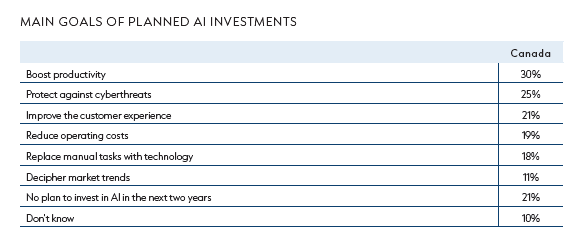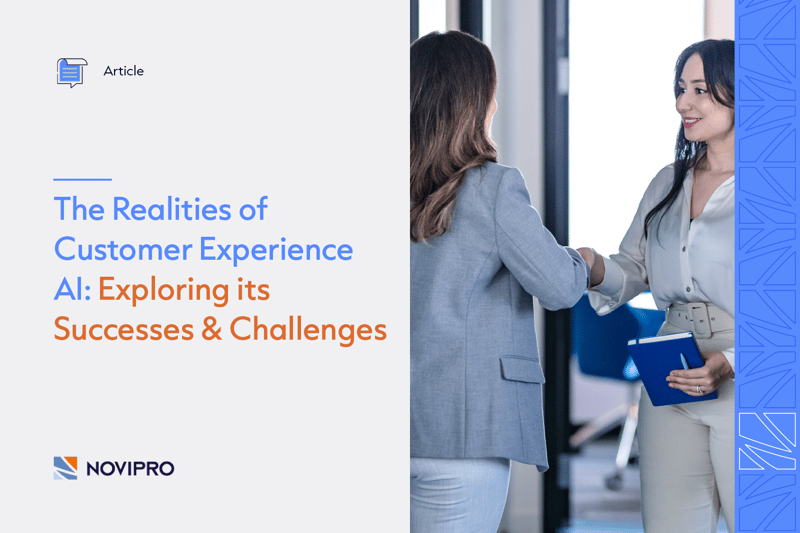In the dynamic landscape of customer engagement, the fusion of Artificial Intelligence (AI) and Customer Experience has emerged as a game-changer. A recent study by NOVIPRO Group and Leger's 7th edition of IT Trends (2023) reveals that 21% of Canadian companies investing in AI prioritize enhancing customer experience. This statistic underscores AI's pivotal role in reshaping the modern marketplace, ushering in tailored interactions and heightened customer satisfaction.

Our exploration of AI in customer experience revolves around unraveling its intricacies. While AI offers personalized experiences, it demands a careful balance between innovation and complexity. Throughout this analysis, we'll objectively examine how AI contributes to, and sometimes complicates, achieving personalized customer journeys. As businesses increasingly integrate AI into their customer interactions, understanding the interplay between technology and human touch is essential for a seamless and gratifying customer experience.
AI and Personalization: Navigating a Complex Landscape
AI has undoubtedly transformed the customer experience through enhanced personalization. However, this allure of tailored interactions comes with its own set of challenges. As we navigate the landscape of AI-driven personalization, it's crucial for businesses to grasp both its advantages and limitations.
Discover more AI statistics in the 7th edition of the IT Trends, download it here!
Successes of AI in Personalization
The success of AI in personalization lies in its sophisticated models that anticipate and fulfill customer expectations adeptly. Through intricate algorithms, AI elevates customer experiences by delivering relevant and satisfying interactions. The nuanced understanding of user behavior empowers businesses to tailor offerings to individual preferences.
Netflix serves as a prime example in personalized customer experiences. Through sophisticated AI algorithms, Netflix analyzes viewing history and behaviors to offer tailored content recommendations, enhancing user satisfaction and retention in the entertainment industry.
Precision Limits: Addressing AI's Mistakes
Despite its capabilities, AI is not immune to misinterpretations. Instances where AI inaccurately interprets user signals can lead to personalization errors and disappointing customer experiences. Businesses must acknowledge these limitations and implement strategies for error mitigation.
A compelling example of AI precision limits comes from YouTube's algorithm. Despite customer feedback mechanisms, a report by Technology Review (September 2022) revealed instances where the platform's recommendations failed to align with user preferences. This underscores the challenge of AI in accurately interpreting feedback and tailoring recommendations, emphasizing the ongoing need for refinement in algorithmic decision-making. The YouTube case serves as a pertinent reminder that even sophisticated algorithms encounter hurdles in fully understanding and addressing user preferences.
Chatbots: Balancing Efficiency and Understanding
Chatbots, powered by AI, offer instantaneous communication but may struggle to accurately interpret user intentions. This underscores the irreplaceable role of human intuition in certain scenarios. Balancing AI-driven efficiency with human insight is crucial for seamless customer interactions.
E-commerce Personalization: Navigating Complexity
In e-commerce, AI excels in delivering precise product recommendations, yet it may falter in understanding nuanced user preferences. Acknowledging these nuances is vital for providing a satisfying online shopping experience.
Netflix's example illustrates the limits of AI recommendations. Despite success, instances were reported where users received recommendations incongruent with their viewing habits, emphasizing the challenge of perfecting e-commerce personalization algorithms. Imagine searching for Ghostbusters on Netflix, only to be recommended horror films, which is not the desired type of movies since AI is considering the word “ghost”.
Delicate Balance: Harmonizing AI and Human Touch
Maintaining an equilibrium between AI automation and human interaction is essential. While AI streamlines processes, human touch adds empathy and understanding crucial for certain customer-centric situations. Striking this balance ensures a harmonious fusion of technology and personalized service.
Bank of America's virtual assistant, Erica, exemplifies this balance by seamlessly transitioning between AI and human agents for optimal customer assistance in the financial domain.
Some companies and organizations would gain from taking inspiration from Bank of America’s model. We note that AI has not yet reached a sophisticated level of personalization enough to totally satisfy clients by itself. Unfortunately, we have all experienced poor customer service at least once due to a lack of personalization and human support.
Conclusion
In the dynamic landscape of AI-driven customer experiences, achieving a delicate balance between innovation and complexity is paramount. While AI promises personalized interactions, it also presents challenges. Real-world examples highlight the journey from AI's successes in anticipating customer needs to addressing precision limits and data privacy concerns.
As demonstrated by cases in e-commerce and chatbot functionalities, the pursuit of perfection encounters obstacles. However, these challenges spur continuous improvement. Future trends offer solutions to current limitations, enhancing the efficacy of AI in shaping customer interactions.
Practical insights, drawn from examples like product recommendations and algorithm intricacies, emphasize the importance of leveraging AI with caution. A nuanced approach recognizes both strengths and limitations, emphasizing ongoing refinement and adaptation.
Moreover, the persistent challenge of data privacy reinforces the need for robust measures. Striking the right balance involves embracing future trends, using AI responsibly, and ensuring stringent data privacy safeguards.
In conclusion, the trajectory of AI in customer experience hinges on maintaining a delicate equilibrium. With practical tips and awareness of challenges, businesses can harness AI's potential responsibly, fortifying the foundations of a seamless, secure, and truly personalized customer journey.








